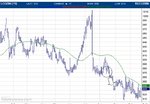I use moving averages too as part of a trend following method, but I don't use them mechanically - ie there is a degree of subjectivity involved. The idea for this comes from Chick Goslin's 'Trading Day by Day' book, and for example if you use a 50-day MA for the long-term trend (as I do), you should learn to anticipate imminent trend changes.
It's a bit difficult to explain briefly but basically if the 50MA is down, but the price is now heading up, and the numbers dropping off the back of the MA calculation look like within the next few days they'll be lower than the new prices coming on the front end, then you can call the trend 'up' and act accordingly. It takes a bit of practice and I then use a MACD (with non-standard settings) for timing and will trade in the direction of the longer term trend (subject to anticipation). You can also apply 'anticipation' to the MACD. So it wouldn't work if you were looking for definitive triggers from indicators, but if you don't mind a bit of gut feel and intuition it works quite well.
I've posted an old random chart of Cocoa - while the 50MA is clearly down, and the circle shows the 'back end' of the data falling out of the 50MA, you can see that within a few days the prices fall quite sharply to around the level that the prices are now: one would anticipate that the 50MA line is going to shallow out considerably. If in the next few days the price started to rise significantly and my MACD trigger suggested a buy, and it moved out of the 850-820 range, then I would anticipate the 50MA turning up pretty quickly too, so would not allow the current falling MA to offset the MACD trigger - conversely if the price were to start to fall and I got a sell signal from my MACD then it would pretty quickly reinstate the negative momentum in the 50MA and that would be a strong sell signal for me.
The second trick is to find good trend following markets, which is essentially a function of volumes traded - ie currencies, interest rate and index markets will generally trend more reliably than individual stocks and so are more suited to MA type methodologies.

